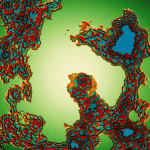Laura was a physician who spent much of her clinical time treating substance abuse disorders, and she had no recent experience with cannabis herself. Her aversion to using cannabis when she was going through chemotherapy for breast cancer did not surprise me. Nausea, and the anxiety that preceded its inevitable occurrence, were disabling. I trained with Laura in family medicine, and I had appreciated the beneficial effects of cannabis used by my cancer patients, but it was hard getting Laura to accept my advice.
Finally, I introduced her to a calibrated vaporizer – a method of administration that could provide quick relief, but was different than the ‘smoke a joint out behind the barn’ approach she had imagined. She started with a CBD-rich herb that had a ratio of 2:1 CBD:THC, hoping that the resulting intoxication would be mild enough to tolerate.
I received a call from Laura three days after her latest chemo, and quickly answered it to see if her trial of cannabis had been helpful to her. At first I was concerned because she was crying into the phone, but when I could understand her words I was thrilled. She reported, “It worked faster, better, and more completely than any of the prescriptions my oncologist gave me.”
If even reading about nausea and vomiting will make you queasy, you may want to jump to the end of this article and skip the potentially nauseating details. Nausea is like that – easy to feel if you are so inclined.
Nausea and vomiting are each distinctive, different problems – clearly related, but quite different when it comes to cause and treatment. Those who suffer know that nausea is worse to live with than vomiting because it is a continuous sensation, and is harder to control.
What is Nausea?
Nausea and vomiting are protective defense mechanisms in the human body, and short-term episodes can be therapeutic, though miserable. But what if nausea is not short-term? What if it is an unavoidable side effect, or chronic, with no relief in sight?
If there is no clear trigger for nausea, a patient should work with their doctor to discover the underlying problem. This is true especially if the nausea does not resolve within a day or two because that may be a sign of more serious problems.
Possible Causes of Nausea
- Migraine
- Head injury
- Seizures
- Ear disorders, including infections
- Motion sickness
- Gastrointestinal disorders
- Appendicitis
- Hepatitis
- Pancreatitis
- Bacterial or viral infections
- Medications–chemotherapy and others
- Toxins–arsenic, pesticides, ricin
- Pregnancy
- Heart attack
- Pain
- Psychiatric or emotional disorders
How Does Nausea Work?
What is happening in the body when we get nauseated? The brain, the GI system, and the nervous system all have a part in this. We know more about the physiology of vomiting than we do about nausea, so we have better available therapies for its relief.
One key to controlling symptoms seems to be receptors in parts of the brain and in the GI tract that produce and bind with serotonin, a neurotransmitter. Zofran, a well-known anti-emetic (anti-vomiting) medication, works by blocking the nauseating effects of serotonin release.
Cannabinoids to Manage Nausea
The non-intoxicating cannabinoid CBD interacts with serotonin releasing receptors, and when given in relatively small doses has been shown to help alleviate both nausea and vomiting. CBD can also be effective in easing anxiety, which can help patients manage the angst of chronic nausea.1
THC also works well for many as an anti-nausea cannabinoid. When THC binds to the CB1 receptors in specific parts of the brain, it acts to reduce vomiting.2 The potentially uplifting side effects of THC can also be therapeutic in this case if not too intense. Creating a more positive state of mind is helpful for anyone going through chemotherapy, or for anyone experiencing difficult-to-treat, chronic nausea.
CBDA, the acidic, raw form of CBD, is even more active at the serotonin receptors, and preclinical (animal) studies indicate that CBDA is a potent anti-emetic, stronger than either CBD or THC.2, 3 CBDA is the form of CBD that exists in the growing CBD-rich plant, before the plant has been dried or heated. With heating, CBDA becomes CBD, just like THCA decarboxylates to become THC. Currently, the best source of CBDA would be juice from fresh, high-CBD plants, but in the future dispensaries may be able to offer CBDA products for patients with need.
Nausea Related to Cancer Treatment
State of mind during chemotherapy can include the “nocebo effect” – negative expectations of treatment – that leads to anticipatory nausea. Just the thought of inevitable side effects can be overwhelming. This is especially true if the first round of chemo is not treated effectively. Prescription antiemetics are not helpful for anticipatory nausea, but cannabis shows promise. Prof. Linda Parker, a behavioral neuroscientist at the University of Guelph in Ontario, Canada, has found that several phytocannabinoids including THC, CBD, and CBDA alleviate anticipatory nausea in conditioned lab animals. Clinical trials on humans are needed.
Where to Start
For patients who have nausea caused by chemotherapy, radiation, or other identifiable reasons, cannabis can provide relief. THC, CBD, and CBDA all show promise in research labs and have already proven themselves in the homes of patients who have experience. Whole plant medicine is more effective than any isolated cannabinoid, but which cannabinoid profile should you start with if this is your goal?
That depends somewhat on your experience with the medicine. If you have never tried this before, it might be best to start with a CBD-rich medicine that still has some THC in the mix, like Laura did. As you get used to the medicine, you can increase the amount of THC as needed. And if you have access to the non-intoxicating CBDA, that would be a very good one to include.
The use of cannabis for nausea, and for vomiting due to chemotherapy or radiation, is accepted by many physicians who do not otherwise recommend cannabis. It is effective, well-tolerated, and while we may not understand all the mechanisms of action we do know it works. Patients should know where their medicine is grown and prepared, and use only lab analyzed cannabis that is free of contaminants. With quality medicine, the chances of relieving nausea may be a single dose away, just like it was for Laura.
Stacey Kerr, M.D. is a teacher, physician, and author living and working in Northern California. Dr. Kerr was in private practice until she decided to write and educate full-time. This article was originally published by Hawaiian Ethos and may not be reproduced in any format without permission from the source.
Footnotes
- Alexandre Rafael de Mello Schier et al, Cannabidiol, a Cannabis sativa constituent, as an anxiolytic drug, Rev Bras Psiquiatr. 2012;34(Supl1): S104–S117
- Regulation of Nausea and Vomiting by Cannabinoids, Br J Pharmacol. 2011 Aug;163(7):1411-22. doi: 10.1111/j.1476-5381.2010.01176.x.
- Bolognini et al, Cannabidiolic acid prevents vomiting in Suncus murinus and nausea-induced behaviour in rats by enhancing 5-HT1A receptor activation. Br J Pharmacol. 2013 Mar;168(6):1456-70. doi:10.1111/bph.12043.
- Keith A. Sharkey et al, Regulation of nausea and vomiting by cannabinoids and the endocannabinoid system Eur J Pharmacol. 2014 January 5; 722:







